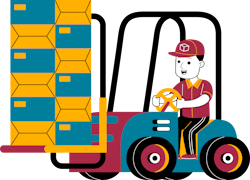In today’s fast-paced world, warehouse operations play a vital role in the efficient functioning of businesses across various industries. Managing a warehouse involves various tasks, including inventory control, order fulfillment, and transportation. One essential aspect of warehouse operations that often goes overlooked is forklift safety training. Forklifts are powerful and versatile machines that are extensively used in warehouses for lifting and moving heavy loads. However, without proper training and adherence to safety protocols, forklift operations can pose significant risks to both employees and materials.
The Importance of Forklift Safety Training
Forklift safety training is crucial for several reasons. Firstly, it ensures the safety and well-being of forklift operators and other employees working in the warehouse. Forklift accidents can result in severe injuries, sometimes even fatal. By providing comprehensive safety training, employers can create a safe working environment and minimize the occurrence of accidents.
Secondly, forklift safety training helps in preventing damage to goods and materials. Forklift accidents can result in significant damage to products, shelves, and infrastructure. Such damage can lead to financial losses and impact the overall efficiency and productivity of warehouse operations.
Furthermore, organizations that prioritize forklift safety training demonstrate their commitment to compliance with safety regulations and industry standards. Compliance with safety guidelines not only protects employees but also reduces the risk of lawsuits and potential legal ramifications.
By implementing forklift safety training programs, organizations can also enhance their operational efficiency. Well-trained forklift operators are more likely to operate the machines with precision and care, thereby minimizing the chances of accidents and errors. This, in turn, leads to smoother operations, faster order fulfillment, and increased productivity.
The Components of Forklift Safety Training
Effective forklift safety training programs typically cover various key components to ensure comprehensive training. These components include:
- Vehicle Operation: Trainees should learn how to operate different types of forklifts, including controls, steering, and maneuvering techniques. Proper understanding and practice of these skills help prevent accidents caused by operator error or lack of familiarity with the equipment.
- Load Handling: Proper techniques for lifting, stacking, and placing loads should be taught to operators. This includes understanding load capacities, load balance, and securement methods to minimize the risk of accidents and damaged goods.
- Safety Procedures: Trainees should be educated on safety procedures and guidelines specific to forklift operations. This includes proper parking, use of seatbelts, maintaining a safe distance from edges and obstructions, and the importance of clear visibility.
- Maintenance and Inspections: It is crucial for operators to understand routine maintenance tasks and how to conduct pre- and post-operation inspections. Identifying and addressing potential equipment issues before usage can significantly reduce the likelihood of accidents.
- Emergency Situations: Forklift operators should be trained on how to handle emergency situations, such as fire, hazardous material spills, or collisions. They should understand the appropriate response protocols and evacuation procedures to ensure the safety of themselves and others in the warehouse.
It is important to note that forklift safety training is not a one-time event but an ongoing process. Regular refresher courses and updates are necessary to reinforce proper practices and keep operators informed about any updated safety regulations or equipment changes.
The Role of Employers in Forklift Safety
Employers bear the responsibility of providing a safe work environment for their employees. When it comes to forklift safety, employers should take the following steps:
- Training Programs: Establish comprehensive forklift safety training programs that cover all the necessary components and ensure that all operators receive adequate training before operating a forklift.
- Safety Policies and Procedures: Develop and enforce safety policies and procedures specific to forklift operations. This includes protocols for equipment inspections, reporting incidents, and practicing safe work habits.
- Regular Inspections and Maintenance: Implement routine inspections and maintenance schedules for forklifts to identify and address any potential issues that may compromise safety.
- Clear Communication: Ensure clear and consistent communication regarding safety procedures, updates, and expectations for all employees involved in warehouse operations.
- Continuous Improvement: Regularly evaluate and assess the effectiveness of the forklift safety training program. Identify areas of improvement and make necessary changes to enhance safety measures.
By prioritizing forklift safety training and adopting proactive measures, employers can create a culture of safety within their warehouse operations.
Conclusion
Forklift safety training is not just a legal obligation; it is an essential aspect of warehouse operations. By prioritizing the safety of forklift operators and implementing comprehensive training programs, organizations can create a safe working environment, prevent accidents, and protect their employees and valuable assets. Proper training ensures that forklift operators are equipped with the necessary skills and knowledge to operate these powerful machines safely and efficiently. It is the shared responsibility of employers and operators to prioritize forklift safety and uphold best practices in warehouse operations.
Click here to learn more about forklift safety training from HCO Innovations.

